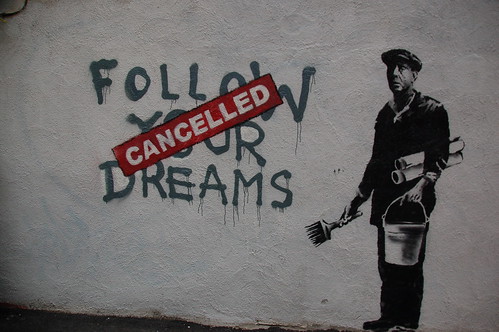
Dan Pallotta, author of Uncharitable, recently spoke to a sold-out crowd in Vancouver, hosted by Vantage Point and sponsored by TELUS. I wasn’t sure at first if his speaking style could sustain the hour+ talk, but he won me (and the audience) over early with his humour and his substance. I had the pleasure of watching the presentation twice – I listened the first time, and tweeted the second.
The basis of Pallotta’s talk was based around two ingratiating issues that face the nonprofit sector. I’ll outline them briefly here, but I also recommend reading the book.
Be like business, without all the benefits of business
Nonprofit organizations are often told they should “be more business-like” or “become more professionalized”. However, the tools that business use to succeed are not available to nonprofit organizations (or perhaps are available, but organizations are harshly judged when they use them). Hence the subtitle of Dan’s book: how restraints on nonprofits undermine their potential. Charities must respond to the great inequities that the powerful tools of capitalism have created, but without using those same powerful tools.
What percentage of my donation is going to the cause and how much to overhead?
This is just a less educated way of asking “are you effective at advancing your mission?” Because evaluation of programs is difficult to do and to share effectively, and the only way that charities officially report on progress is through CRA reports and return, the easiest (but not the most valid) way of measuring charities’ effectiveness at advancing their missions is through financial ratios that show how much money goes to programming (aka “the cause”) vs other costs, like administration and fundraising (also “the cause” but somehow not understood as so).
Constraints
Dan deals with these two issues with describing the constraints they put on nonprofits.
- Compensation: “Nonprofit salaries should be low.”So, apparently it’s OK for people to get paid well if they play football, or refine oil, or create magic weight loss pills. But if they are doing good, attempting to rebalance the inequities of our world, getting paid well is taboo. Because of the feel good “psychic benefit” we’re told.The nonprofit compensation debate in Canada came to a head recently when Liberal MP Albina Guarnieri proposed Bill C-470 (which Dan rebutted in an op-ed piece), which seeks to limit nonprofit compensation. However, I would like to note that financial incentives indeed are important for furthering the good in the world. There is a reason that we offer tax receipts for donations to charities. The feeling of doing good doesn’t do it all. And if we truly want hunger eradicated, our rivers protected, and our diseases cured, should we be attracting the best and the brightest to do it?Someone I met recently attacked the salary (not even the level of salary, just the fact that there was a salary) of the SPCA CEO. “A volunteer could do that,” he said. Umm, a volunteer could run an organization with a budget of over $10 million dollars and a staff in the hundreds? We wouldn’t imagine asking that of a private sector CEO.
- Marketing. “Nonprofits shouldn’t pay for advertising.”Dan argues that it would be irresponsible to put a new product out on the market and not advertise. But somehow nonprofits are held to a different standard, even though nonprofits are fighting for a market share of consumer spending like any other business.
- Risktaking. “Nonprofits should not take risks when fundraising.”If an event or campaign isn’t profitable in its first year, it will likely be squashed. However, success is built on experience, which means that new, innovative and perhaps risky fundraising opportunities are not sought out. Many businesses are not profitable in their first year(s), but again, nonprofits in general and fundraising campaigns more specifically are held to a different standard.
- Long term investments. “Nonprofits results have to happen now or else.”Nonprofit funding from large proportions of their revenue bases (government, foundations, corporate giving) is often done on a yearly basis. Which means that any outcomes of the program have to happen within 12 months. However, the private sector benefits from huge investments over years in research and development before final products go to market. Nonprofits lack that advantage.
- Profit incentives. “Nonprofits can’t offer profit incentives in order to grow.”Private and public companies benefit from being able to offer the opportunity for financial profit over time in exchange for an influx of growth capital. Small examples of this exist in Canada (CDCs, or community development corporations) but a whole new corporate model needed to be created for these types of organizations. Revenue generating arms of nonprofit organizations miss out on this opportunity.
Dan asks: if organizations with purposes of community benefit aren’t able to do these five things, how can they be expected to succeed?
Perhaps we should remark upon was has been done to date in spite of all of these expectations and constraints existing since the beginning of charity.
So what about the issues with “overhead”? The CBC infused fear into the public’s perception of nonprofits when it ran a series on nonprofit overhead and costs of fundraising. This has been responded to (fairly pathetically, I might add, but hey, nonprofits aren’t supposed to pay for advertising at therefore have weak relationships with news agencies, so it’s OK that the alternative voice was heard so weakly, right?) by many, including Vantage Point and Imagine Canada. Sure, there are crooked organizations in the nonprofit sector, but these are crooks, not nonprofits.
Dan takes issue with three factors.
- A focus on overhead leads to overhead being taken to be separate from “the cause”. Overhead is part of the cause. The fundraiser, the accountant, the HR manager, the receptionist, the maintenance staff – these are all important roles that make an organization function. Without them, the programs (aka “the cause”) wouldn’t exist, or would function less effectively. Just as in the private sector, a product is more that just the sum of its parts.
- A focus on overhead leads nonprofits to forgo things that are needed to advance causes. In an effort to keep overhead low, nonprofits may be unable to hire experienced, strategic staff that are going to advance a cause more effectively. They may cut out professional development, which means the nonprofit would lose out on enhanced skills, productivity, and likely high staff retention. They cut out marketing costs, which may decrease awareness of the cause and donations to the cause.Dan counters, “Fundraising isn’t sexy but it’s where the hope lies. If we want to ramp up impact, we need to invest in fundraising.”
- A focus on overhead gives donors bad information. The problem with looking at overhead is that overhead only addresses efficiency, but not effectiveness. Would you buy a pair of uncomfortable shoes littered with holes and made from toxic materials if the overhead of the shoe company was low? “Sure, the shoes are shit, but man, that overhead, wow is it ever low!”Yet somehow, we measure the value of our nonprofits based on overhead, not how well they are advancing their missions. Even Charity Navigator, one of the most often referred to charity evaluator in the US, says that evaluating the effectiveness of charities’ programs is out of their scope. They measure some sort of efficiency, which does not give the full picture to donors.
Dan offered a variety of humourous anecdotes to shed light on these issues, but what was missing was how to tangibly change the public discourse around these issues. He was speaking to a room of converts, and the room was overflowing with self-reassurance and pats on the back. However, how do we respond to questions and criticisms about our practices and our overhead? Dan covered the “what?” and “so what?”, but missing was the “now what?”
But, as this post is going on way longer than I expected (really, if you’ve got as far as this, you should probably just read Dan’s book), I’ll propose some “now what?” in a future post.
So in the meantime, I want suggestions. How would you respond to these questions and comments?
- Wow, I heard how much your CEO makes. That’s ridiculous. She’s siphoning off money that should be going to the <insert disadvantaged population>.
- I’m not sure about donating to your cause. How much of my donation is going to actually go to the cause instead of overhead?
- I saw your ad in the front of Vancouver Sun. How can you justify those sorts of costs?
- You shouldn’t be expecting a high salary if you work for charity, because doing good makes you feel good.

